As usual, I have been basically terrible at keeping this place up to date and generally maintaining contact with people. Here's a short description of my activities since March of this year.
End-March, 2015: I drove from Saskatoon, SK, to Kitchener, ON, to start my new job as a post-doctoral researcher at the University of Waterloo, working with Dr. Maria Strack in the Department of Geography and Environmental Management. At the time, I did not know if I would be spending my entire summer outside of Ontario, or would be visiting field sites for days or weeks at a time but basing myself in Kitchener/Waterloo.
April 1: In what has so far not turned out to be an April-Fool's prank, I started as a post-doc at U Waterloo. Among the first decisions to be made, among such tasks as acquiring keys and locating work spaces, was that I was to spend 4 months in Alberta. As such, there was no need for me to find my own apartment and I could save thousands of dollars in rent money.
May 6: I flew to Edmonton, AB, and then was delivered to the house in the tiny town of Seba Beach, AB.
May 7: We - I'll describe my coworkers in a moment - got started on the project. Briefly, Dr. Strack has an ongoing series of experiments looking at the process of cutover peatland restoration. After draining, clearing, and harvesting a peatland (either a bog or a fen, depending on local hydrology), restoration of the peatland involves returning the ecosystem to something resembling the natural site that was there before. This is very complex, but one approach is to examine ecological function, such as the net movement of carbon into or out of the ecosystem. Immediately after harvest, an exposed field of decomposed peat is a strong exporter of carbon, in the form of both CO2 and CH4 as the microbes in the peat digest the organic matter. As plants re-establish themselves on the field, their photosynthesis and changes in water movement patterns eventually leads to a situation in which the field as a whole is a net sink for carbon, with growth and accumulation outweighing respiration and near-surface populations of methanotrophic bacteria consuming all or nearly all of the CH4 still produced in deeper layers.
Coworkers: At the beginning of the summer, I was working with Ali, recently graduated with a B.A. in Geography at U Waterloo; Stephanie, working a co-op term with us after her second year of her Geography B.A.; and Cristina, AKA Dr. Cristina Lazcano, post-doc / adjunct prof. in the Geography department at the University of Calgary. Stephanie went to Manitoba in late June to replace a worker who quit. In late July we (Ali, Cristina, and me) were joined at Seba Beach by Sabrina, who started her M.Sc. with Dr. Strack in September. We had a few other visitors, but most such visitors were at Seba Beach for their own projects, which may overlap with what we were doing but they were not there to help us directly.
June 1: Convocation at the University of Saskatchewan, Saskatoon, SK. Because I knew well in advance I needed to get myself from Seba Beach to Saskatoon at the end of May I decided to gamble on vehicle ownership. At some point in April, while I was in K/W, I came up with what I thought of as my "Summer Truck" idea, and that it would be mildly crazy and a gamble. It was, but in a very good way - I like to think I won that gamble. My truck, now named Tarrandus*, has been fantastically useful.
* My truck is a 1997 Ford Ranger XLT. The name Tarrandus comes from the scientific name for caribou / reindeer, Rangifer tarrandus.
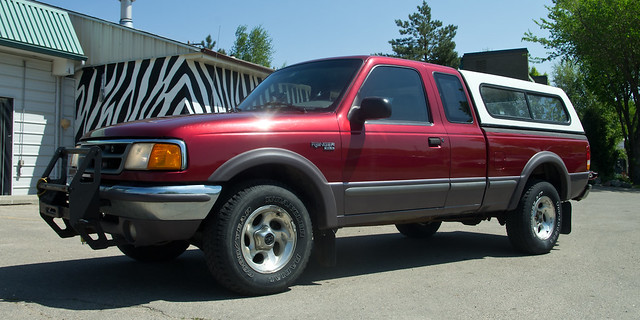
Tarrandus, seen here parked in front of a shop near Charlie's and my former apartment in Saskatoon. I intend to paint the white canopy in black-and-white dazzle camoflage, and I thought this shop's zebra stripes served as a first look.
June 4-6: Canoe trip with Charlie. Charlie and I have established our own tradition of canoe trips on prairie rivers on (or near) the May Long Weekend. This year, because of my work schedule and the date of convocation, we decided to have this trip a few weeks after May-Long, in early June. We completed the trip we had started two years previously, travelling down the Qu'Appelle River from our rescue-pickup location to Buffalo Pound Lake.

Our tent, shortly after a "gully washer" - a small, intense storm typical of summer rainstorms on the prairies - had blasted down the valley and repainted the sky.
June 28-July 2: ICoN4 Meeting, Edmonton, AB. Four years ago I attended the second International Conference on Nitrification (and related processes) in Nijmegen, Netherlands. The third meeting was in Japan and I was not able to attend, but the fourth was in Edmonton and when that decision was made I was in Saskatoon and knew I'd probably be able to attend. Seba Beach is only about 80 km from the University of Alberta where the conference was held.
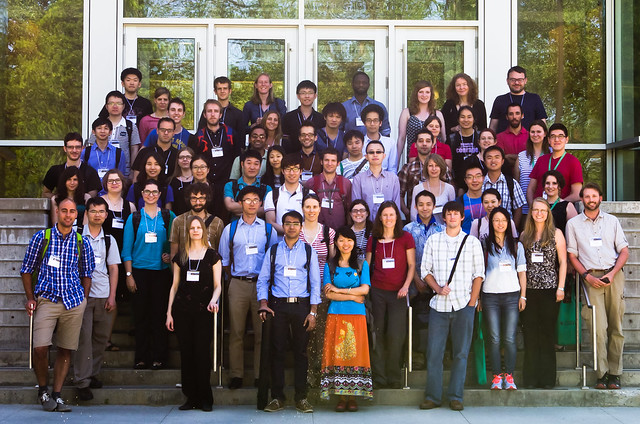
This photo of the pre-conference workshop attendees was "favourited" and re-tweeted when I uploaded it to Twitter, mainly by other attendees or their academic collaborators.
July: I travelled to Saskatoon three times in July, to spend time with Charlie and to pack up our apartment there and move some items to Regina. Charlie moved to Regina for August 1, but my stuff as well as her items we could move to Regina before August were placed in a friend's garage in Regina. My stuff is still there, Charlie has moved into a fine apartment.
Also in July, plans formed for me to spend some time in September at various field sites in Western Canada. My coworkers, including other members of Dr. Strack's lab working in other places across Canada, finished their field seasons in late August, variously returning to their homes around August 21 to August 25. I had no fixed dates to be in Ontario to restrict me, so when opportunities for early-autumn fieldwork were raised I quickly agreed.
August 10(ish): The Vegetation Survey at the Seba Beach sites started to take over my life. Early plans were to complete the Veg Survey in the last full week of work, approximately August 24-28, under the assumption this would constitute only four or five days of work. In reality, the Veg Survey grew into a monster that completely consumed all other tasks over three full weeks. We placed around 600 quadrats on a grid of transects covering about ½ of the total area of the Restored Site and all of the (much smaller) Unrestored Site. Then there were accessory tasks, like biomass collection and some side-projects involving the spread of Birch trees into the Unrestored Site.
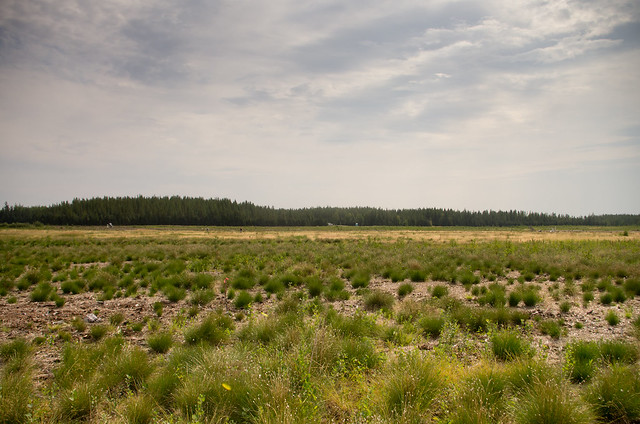
I took this photo during a short break from laying transects, while I was near the western edge of the Restored Site. If pink or orange flagging tape is visible in this photo, those are quadrat positions on the transects.
August 15: I was invited to a wedding in Nisku, AB, just south of Edmonton. Charlie’s friend Moose was attending a cousin’s wedding, and needed a neutral party along to help avoid or diffuse any family-history based awkwardness. I love weddings – any excuse to party, and a wedding is a damn good excuse and opportunity for that – and August 15/16 was pretty much my last free weekend of the summer so of course I went. I stayed at Airways Country Inn – Nisku is adjacent to Edmonton International Airport – which is a hotel catering mainly to truck drivers, and attached to Peelerz, a strip club. I did not go in to Peelerz, but I did enjoy my complimentary beverage (Gin & Tonic, for me) at Drillers, the lounge / restaurant at the hotel. My gift to the couple was a tea set from the knick-knacks shop across the street from the house in Seba Beach. Tea sets, it turns out, are kind of a specialty of that shop.
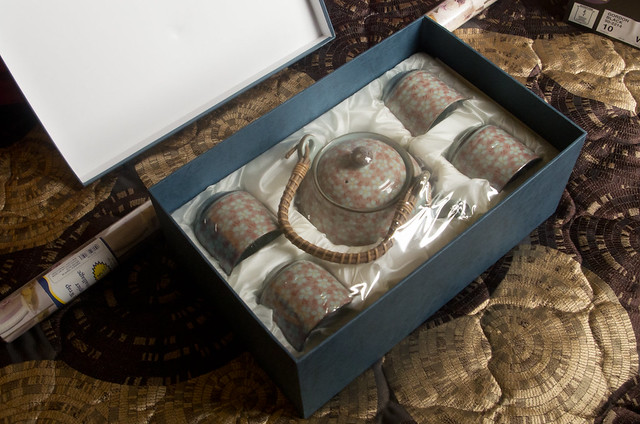
My gift to the couple with the unpronounceable names. Think stereotypical German meeting stereotypical Ukrainian, then throw in a hopelessly monolingual Anglo like me.
August 21: Charlie arrived – in Red Deer, I drove down there to pick her up after a day in the field - to spend a lovely weekend with me at Seba Beach, then she was a tremendous help with the final parts of the Veg Survey and some of those side-projects that we’d put aside during the main Veg Survey work.
August 28: Very early in the morning, Charlie and I dropped off the other three people (Ali, Sabrina, and Scott, sent to us from McGill to help. So I was wrong about none of the visitors helping us, above) at Edmonton International Airport, and then spent the rest of the day and most of the weekend relaxing at Seba Beach. It really is a very nice place to spend time, at least while the weather is good in the summer.
August 30: Charlie took Tarrandus to Saskatoon to help her complete her move to Regina, and I drove to Fort McMurray with Kim, M.Sc. student in Maria’s lab. Kim had spent most of the summer in Ft. Mac, and there was an opportunity for her to collect some early-autumn data from her sites there; I went along because I like those opportunities. Also for various fieldwork general-safe-practice reasons and because it’s good for me to show my face at Suncor in Ft. Mac for reasons to do with where my post-doc funding comes from.
August 31-September 6: Kim and I braved the terrible, terrible September weather of Fort McMurray and got the work done. Once again, UPS was involved and managed to be utterly awful in every way – that’s a rant for another day, but the short version is: DO NOT USE UPS. Despite these difficulties we had a pretty good work week and I’m happy with the data and samples we pulled out of the various wetlands there.
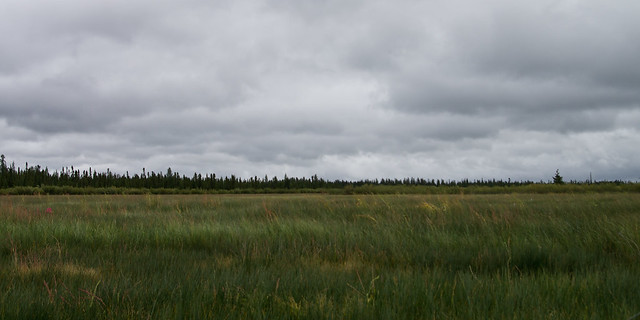
This is a view of "Saline Fen", one of Kim's study sites. Photos from the main study site on Suncor's mine have to be approved by Suncor before I can show them to anyone else.
September 7-10: Another opportunity for early-autumn fieldwork; Cristina and I collected a final round of gas-flux data at Seba Beach, then packed up the equipment and supplies, cleaned the house, and drove to Calgary on September 11.
September 12-13: Weekend in Calgary. I spent some time with my friend Rick who I hadn’t seen in several years; good times were had in a dim basement with bad movies and violent video games, just like old times. A++ would click frantically under fluorescent lights again.
September 14: I took a Greyhound bus for the first time in my life, from Calgary to Regina. This represented a bottleneck in my movements, because baggage restrictions on an inter-city bus are similar to those on an airplane. My usual habit of just tossing everything into the back of the car or truck was not useful here. The trip itself was pretty uneventful, and simultaneously less boring and less exotic than perhaps I had been expecting.
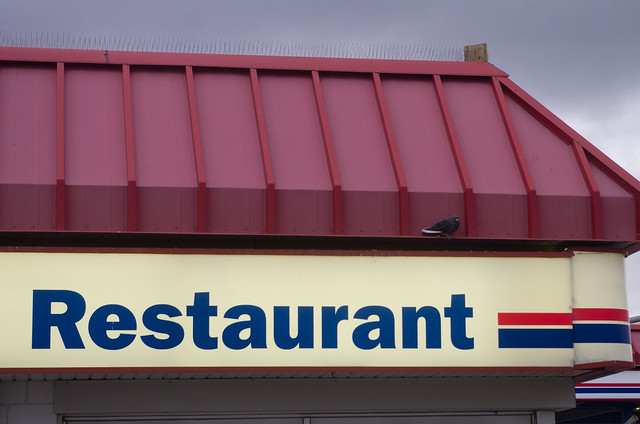
This pigeon had found a perch among abundant anti-pigeon devices, and seemed entirely unconcerned by my presence as I waited for the bus to return to the Husky station. The passengers had been deposited at this Husky station for 30 minutes, not enough time for me to enjoy a meal at the restaurant, and I didn't want to spend my time with the other passengers in any case, most of whom were smoking outside of the convenience store.
September 15: After only a few hours with Charlie I drove from Regina to Brandon, MB, to stay with Dr. Pete Whittington of the Geography Department at Brandon University. He is involved in peatland restoration projects in Manitoba (as well as other places) in cooperation with Dr. Strack and Dr. Line Rochefort of Université Laval. Dr. Whittington loaned me his drone after a bit of practice flying; a drone is a fun toy and I want one. I’m not sure what I might *do* with one outside of work, but they still seem like tremendous fun.
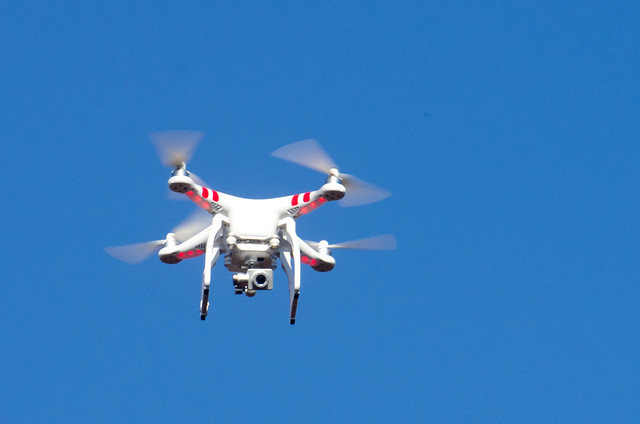
I took this photo in Manitoba while I was assisting another researcher at a site. I deliberately treated it like I would a bird, just to practice my birding technique.
September 16: I left Dr. Whittington’s house early in the morning, and had breakfast at the Husky House restaurant beside Highway 1. That would be entirely unremarkable except for two things: there was a clearly mentally-ill older man at a table who spent the entire time I was there talking to the various voices in his head, and the food was not the best I’ve had. I generally like Husky House restaurants for breakfast, I can get a “traditional” breakfast of eggs, bacon, toast, hash browns and unlimited coffee for a reasonable price (that would make an American, accustomed to IHOP and Waffle House, weep for the prices Canadians pay for such fare). It was still pretty good, just not as good I usually expect.
My plan had been to pick up Ali at Winnipeg International Airport around 11:00, but heavy traffic on the 401 meant she missed her flight from Pearson (Toronto). She made it to the check-in counter before the plane actually took off, but not through security and to the gate in time to board. Air Canada allows passengers in such a situation to take the next available flight for no additional charge, so I received a text from Ali just after breakfast describing this situation and giving me 3.5 more hours to do whatever I wanted. So I visited Spruce Woods Provincial Park, between Brandon and Winnipeg.
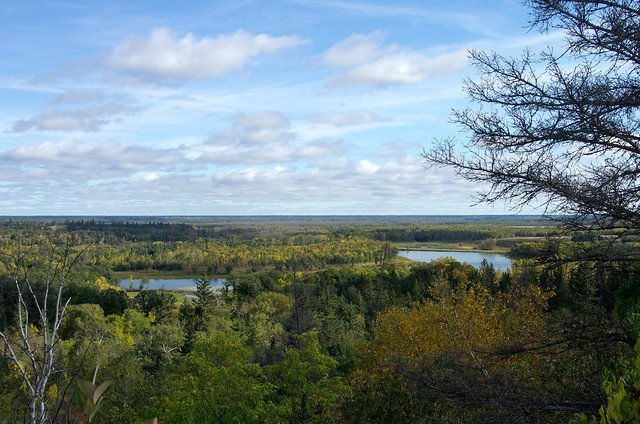
Spruce Woods is an excellent provincial park. I went to the sand dunes there, and took this photo from the top of the hill just north of the dunes where an observation platform has been built that allows some tremendous views. Marshs Lake (no apostrophe, and this is not the usual plural of "marsh") has a walking trail around it and if I'd had more time I certainly would have explored it.
I have spent the time since September 16 at the Moongate Bed & Breakfast, about halfway between the two tiny towns of Elma and Whitemouth in eastern Manitoba; we are not far from Whiteshell Provincial Park. This B&B is quite pleasant, with a full kitchen that makes our lives much easier (and cheaper) than relying on a hotel / restaurant combination. If you follow the link, you might see that Moongate advertises itself as a retreat from the pressures of the modern world, including such nuisances as cellphone reception and the internet. This digital isolation (they use the term “digital detox”) is a bit of an obstacle to some of our work here, and I am posting this from the boardroom at Sun Gro’s Elma plant.*
* That was my plan. I wrote most of this yesterday, and I had intended to return to Elma Plant in the late afternoon but was distracted by the availability of good beer at the local "country" store. I am posting this from the house patio at Moongate, where the owner's wi-fi leaks out.
Ali returned home on the 22nd, and I finished the last few tasks of projects I am directly involved in here yesterday (23rd) morning; now I am a field assistant for Marie-Claire. Marie-Claire is a kind of researcher / lab manager / general task-manager and student-wrangler working for Dr. Rochefort at Laval, and is here in Manitoba to supervise some new restoration efforts at Sun Gro’s operations. We have been spending a fair bit of time out at the field to be restored, discussing plans with a highly capable and very easy-to-work-with heavy equipment operator named Bruce. He can draw straight lines across the landscape with his dozer in a way that makes me and my wobbly transects look like a drunken moose leaking bright pink flagging tape.
I will be here until Marie-Claire’s work is complete, which mostly means until she is satisfied that Bruce is doing exactly what she wants him to do as he fills ditches, damns drains (i.e. big ditches), and constructs “bunds” out of raw peat. I had thought this might be early next week, but it is now looking like we will depart next Thursday or Friday, or about one week from today.
If I do leave eastern Manitoba on Friday, then my field season will have been 149 days long, or nearly three times my longest stay in the Arctic, the 53 nights I spent in a tent at Alexandra Fjord in 2009. Of course, in the High Arctic by mid-September there is not-melting-this-year snow on the ground and air temperatures are averaging zero or lower, while here in south-eastern Manitoba we still have many of the signals of summer, including the blackflies and mosquitoes that bit me earlier this afternoon (yesterday afternoon, see above asterix), and some signals of autumn, such as the hyper-aggressive wasps that did not appreciate my appreciation of their volleyball-sized nest in a short tree. The swelling in my hand has almost completely faded (it's gone completely now, though a faint itchy feeling remains).
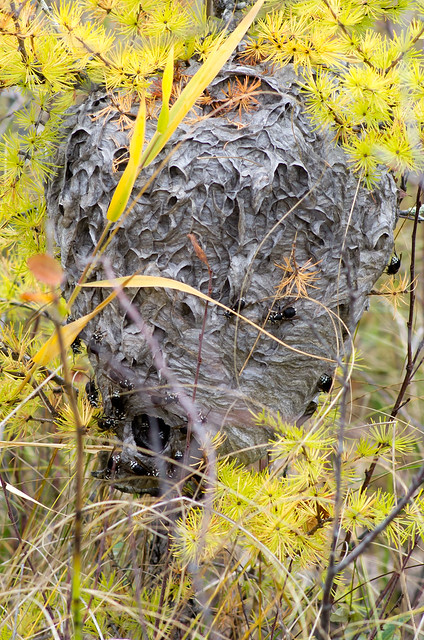
The nest, with angry wasps patrolling the exterior.
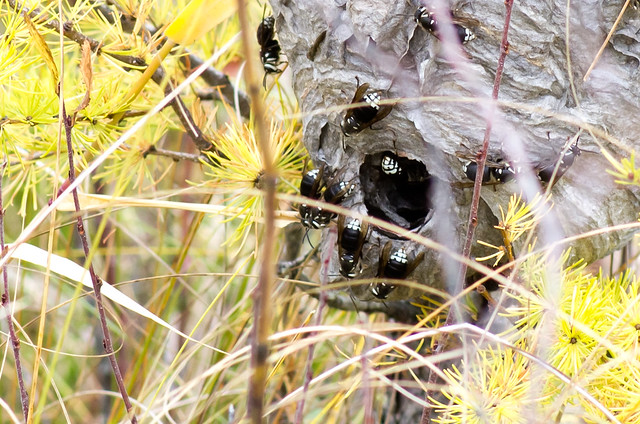
A close-up look at the entrance and entrance guards. This is a heavily cropped version of a photo taken with my 105mm telephoto macro lens; I did not get close to the nest a second time!


No comments:
Post a Comment